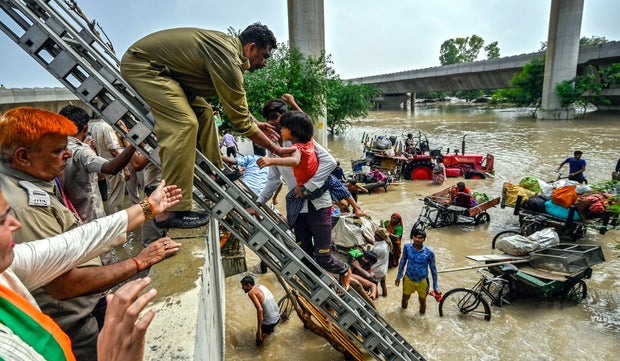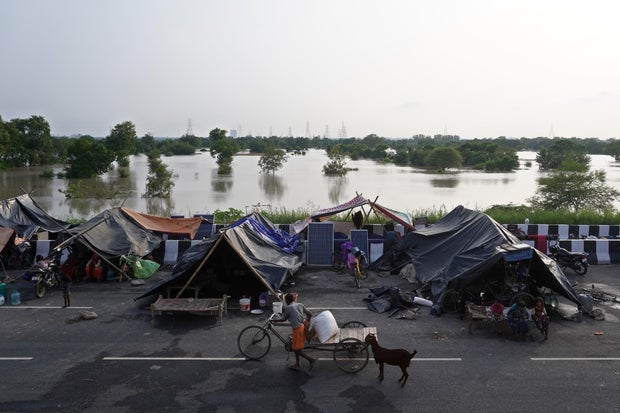India’s monsoon rains flood Yamuna river in Delhi, forcing thousands to evacuate and grinding life to a halt
New Delhi — Authorities in India’s capital region evacuated thousands of people and ordered all schools and colleges to remain closed until Sunday as a major river running right through Delhi spilled over its banks late Wednesday, flooding homes and major roads. People were urged to stay inside and work from home if possible as the flooding threatened to inundate more of the city, which is home to some 30 million people.
Many rivers across northern India have been swollen over the last week by record monsoon rains hitting the region. The states of Himachal Pradesh, Uttarakhand, Haryana, Punjab, and Uttar Pradesh have all seen widespread destruction and, as of Thursday, almost 100 deaths were blamed on house collapses, landslides and flash floods unleashed by the monsoon.
Raj K Raj/Hindustan Times/Getty
Some parts of the Delhi subway system, which is used by 2.5 million people every day, were also shut down, putting more pressure on the waterlogged roads which quickly became choked with massive traffic jams. Several key roads were completely flooded.
Local TV channels showed video from several low-lying areas that had been totally submerged by the waters from the Yamuna river, with people struggling through the flooded streets to reach higher ground.
The city’s Chief Minister Arvind Kejriwal, who ordered the emergency measures, said the water level was still rising “very fast” Thursday and urged people to stay home “as much as possible.”
ARUN SANKAR/AFP/Getty
His administration said it had prepared more than 2,000 shelters for people displaced by the flooding. About 16,000 residents had been evacuated from low-lying areas of the city by Thursday afternoon.
The water level in the Yamuna hit a 45-year high Thursday afternoon at 684 feet, breaking the previous record of 681 feet set in 1978. The Yamuna swelled particularly abruptly Wednesday after authorities released more water into it to relieve pressure on a dam in the neighboring state of Haryana. That brought the record water levels in the capital even though it hadn’t rained heavily in Delhi for a couple days.
There was concern the sprawling Indian capital could face a drinking water shortage in the coming days as three water treatment plants in the city were flooded. The three plants provide fresh water to about a quarter of the city’s population.
Mayank Makhija/NurPhoto/Getty
Delhi and many other major cities in India grapple with flooding regularly during the rainy season, which runs from June to September. While destructive, the monsoon rains have long been a lifeline for agriculture and drinking water supplies in the region.
Many residents in Delhi, Mumbai, Bangalore and other huge cities have consistently blamed mismanagement and poor drainage systems for the regular waterlogging.
While it’s eased recently, this year’s monsoon in Delhi was also a record-breaker. The capital was hit with a punishing six inches of rain last Saturday alone, the highest single-day downpour in 40 years.
Scientists say global warming and climate change are making extreme weather events like floods, cyclones, heat waves in India more frequent, more intense and more unpredictable.
For all the latest World News Click Here
For the latest news and updates, follow us on Google News.




